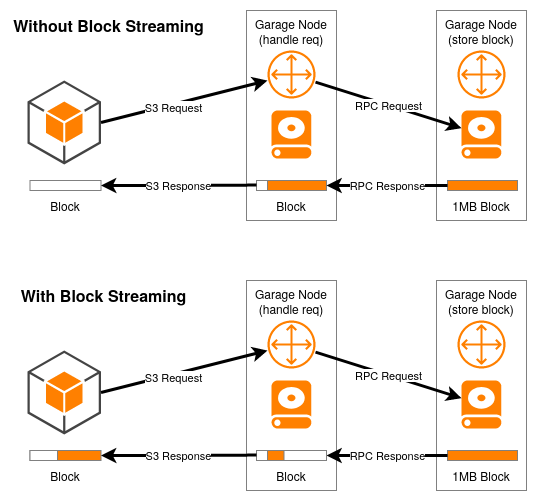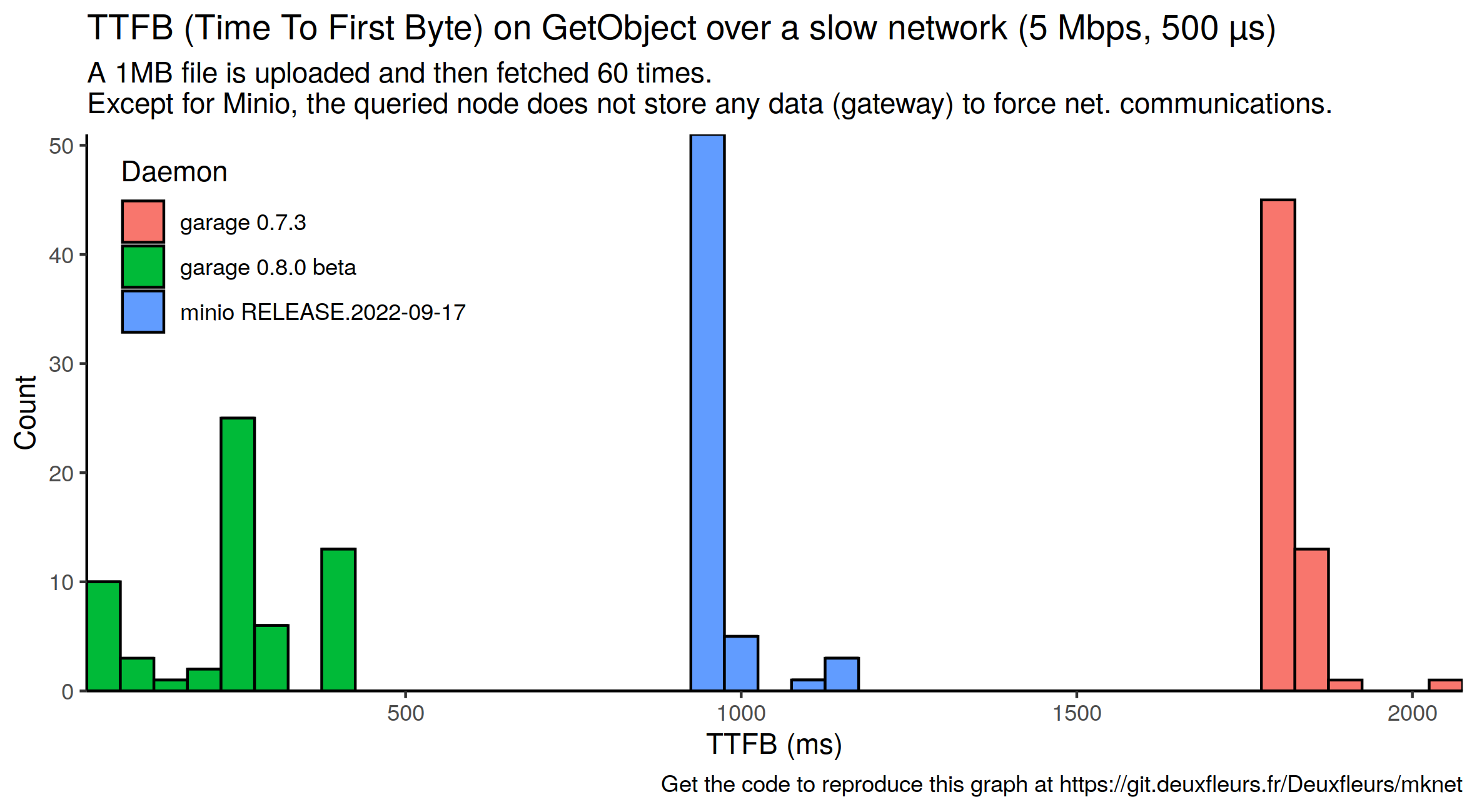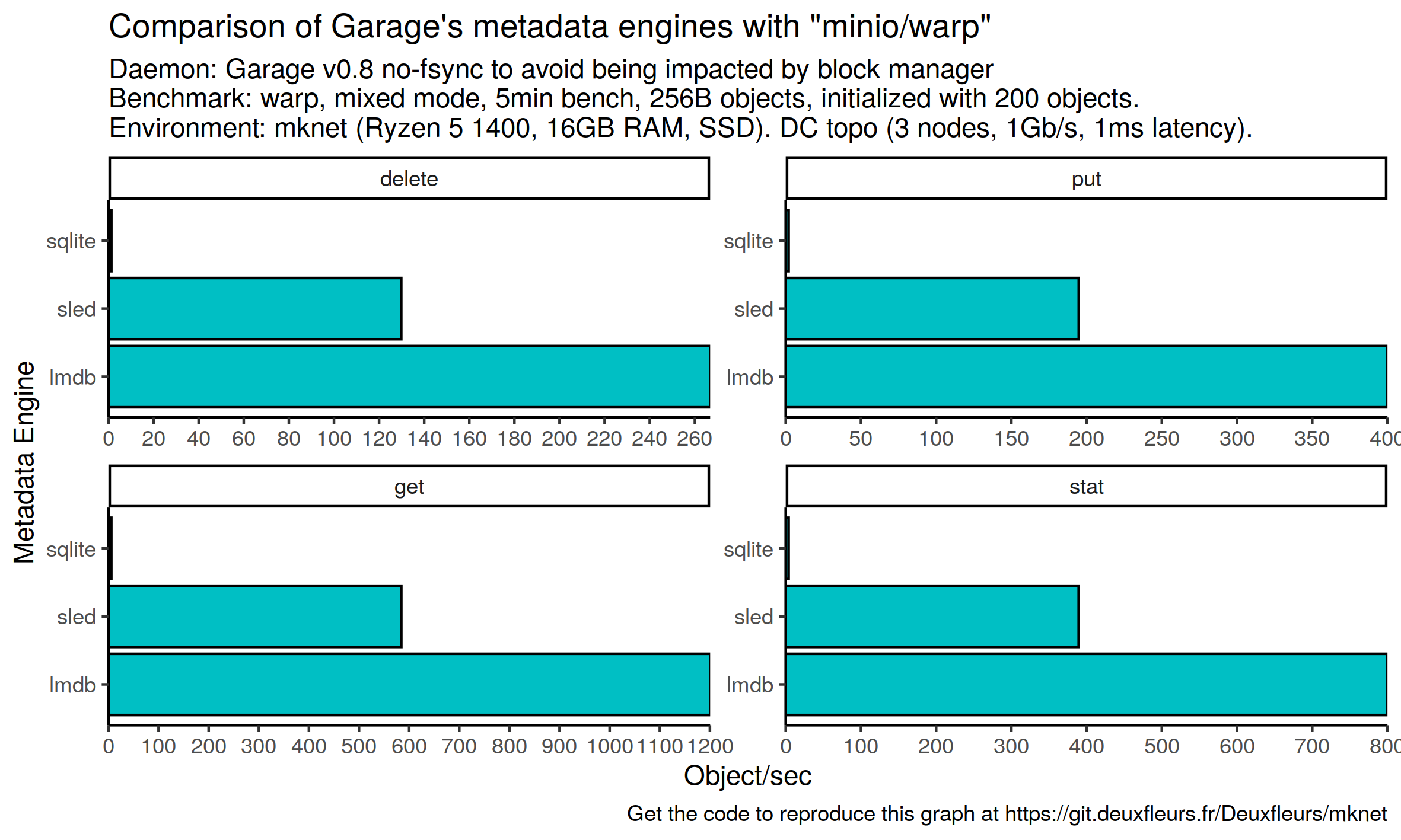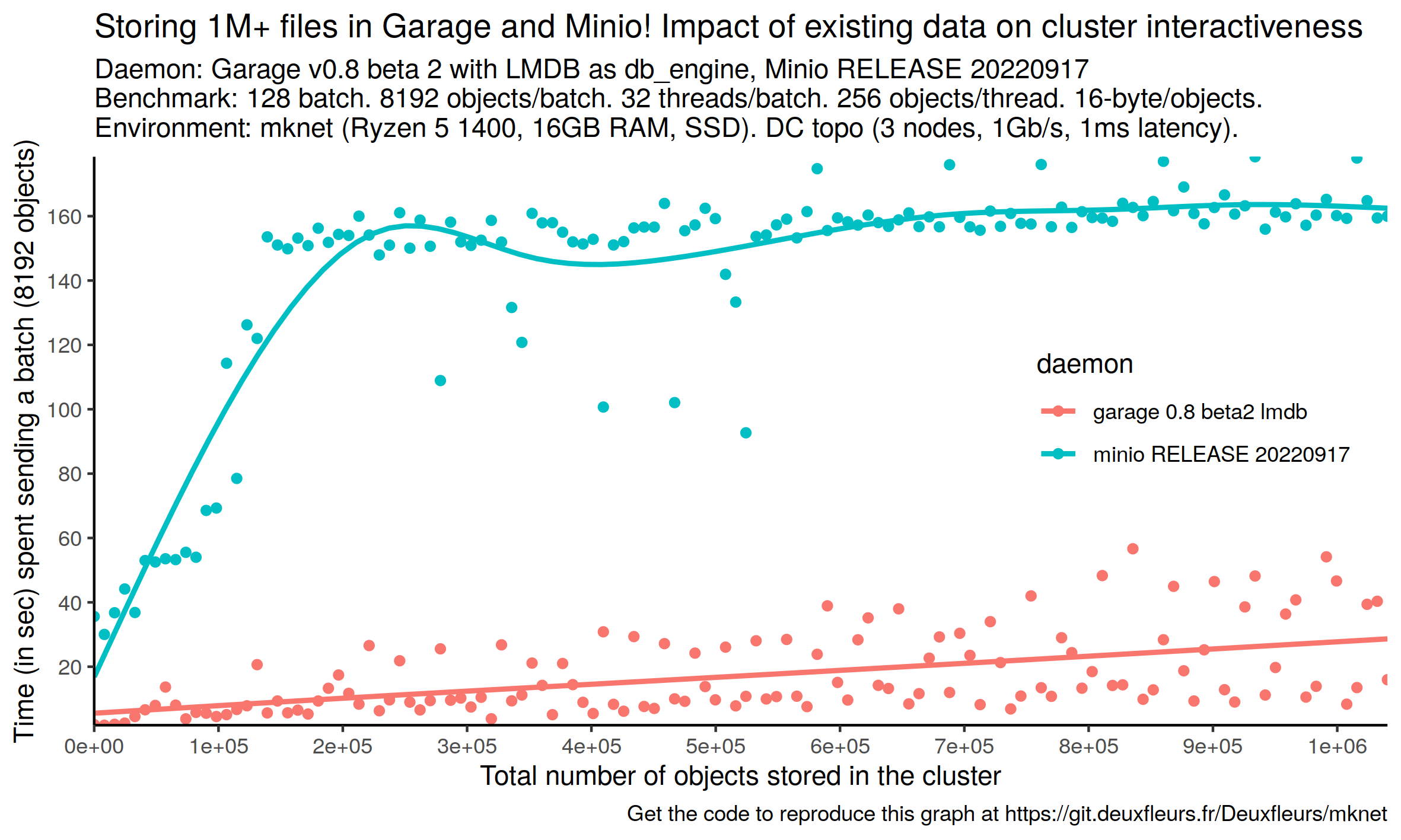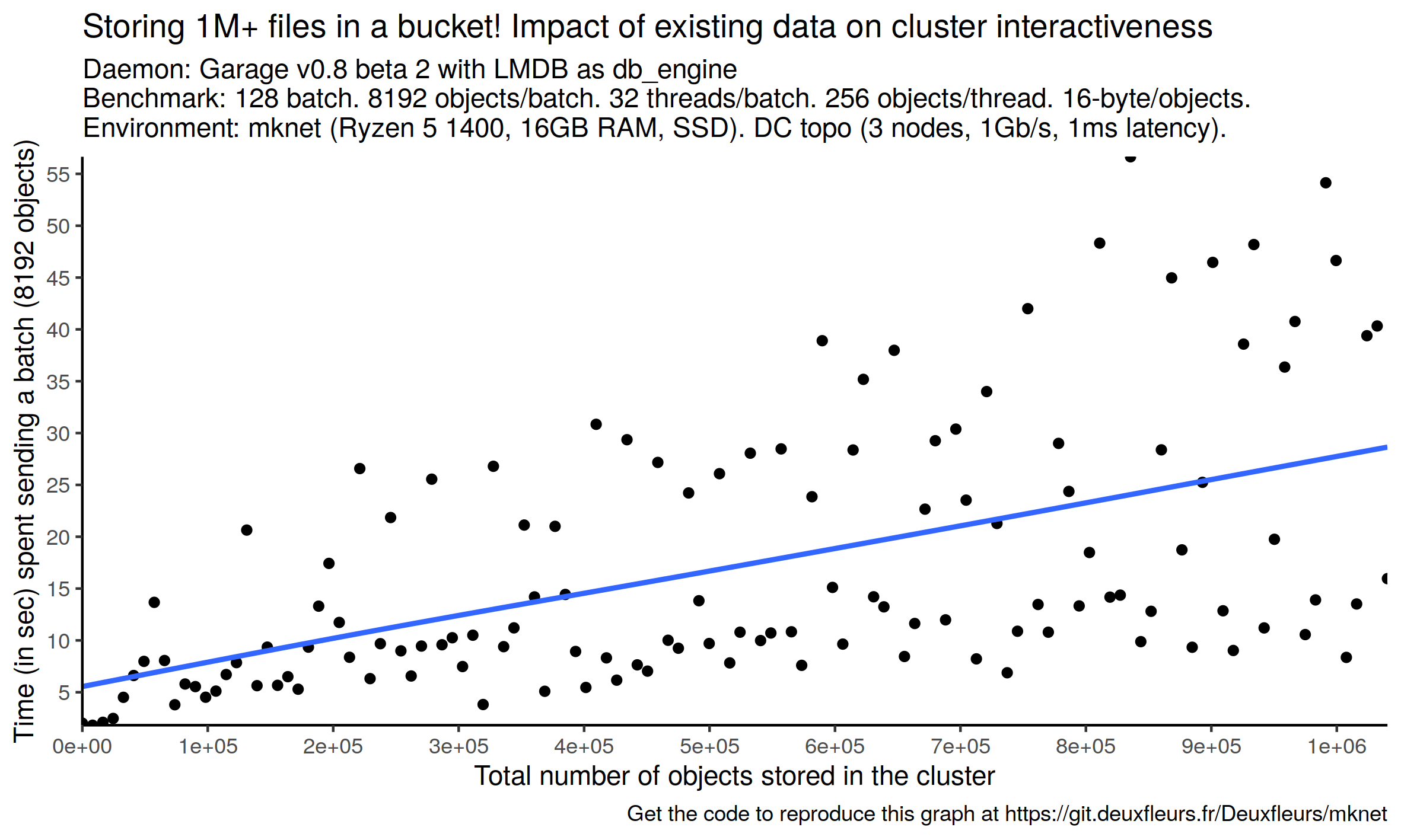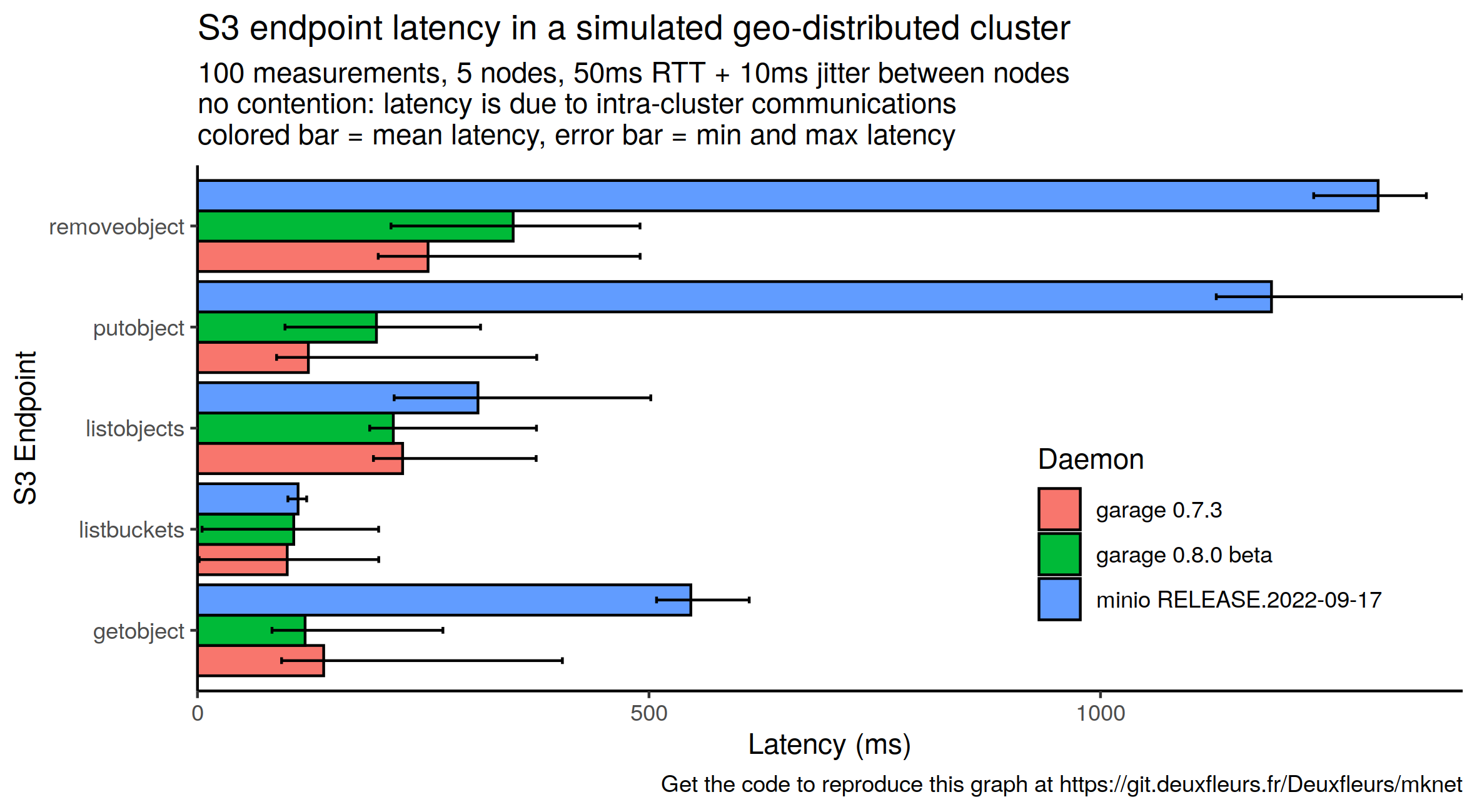10 KiB
+++ title="Bringing theoretical design and observed performances face to face" date=2022-09-26 +++
For the past years, we have extensively analyzed possible design decisions and their theoretical tradeoffs on Garage, being it on the network, data structure, or scheduling side. And it worked well enough for our production cluster at Deuxfleurs, but we also knew that people started discovering some unexpected behaviors. We thus started a round of benchmark and performance measurement to see how Garage behaves compared to our expectations.
⚠️ Disclaimer
The following results must be taken with a critical grain of salt due to some limitations that are inherent to any benchmark. We try to reference them as exhaustively as possible in this section, but others limitation might exist.
Most of our tests are done on simulated networks that can not represent all the diversity of real networks (dynamic drop, jitter, latency, all of them could possibly be correlated with throughput or any other external event). We also limited ourselves to very small workloads that are not representative of a production cluster. Furthermore, we only benchmarked some very specific aspects of Garage, on which we are currently working on: our results are thus not an overview of the whole software performances.
For some benchmarks, we used Minio as a reference. It must be noted that we did not try to optimize its configuration as we have done on Garage, and more generally, we have way less knowledge on Minio than on Garage, which can lead to underrated performance measurements for Minio. It must also be noted that Garage and Minio are systems with different feature sets, eg. Minio supports erasure coding for better data density while Garage doesn't, Minio implements way more S3 endpoints than Garage, etc. Such feature have necessarily a cost that you must keep in mind when reading plots. You should consider Minio results as a way to contextualize our results, to check that our improvements are not artificials compared to existing object storage implementations.
Impact of the testing environment is also not evaluated (kernel patches, configuration, parameters, filesystem, hardware configuration, etc.), some of these configurations could favor one configuration/software over another. Especially, it must be noted that most of the tests were done on a consumer-grade computer and SSD only, which will be different from most production setups. Finally, our results are also provided without statistical tests to check their significance, and thus might be statistically not significative.
When reading this post, please keep in mind that we are not making any business or technical recommendation here, this is not a scientific paper either; we only share bits of our development process as honestly as possible. Read benchmarking crimes, make your own tests if you need to take a decision, and remain supportive and caring with your peers...
About our testing environment
We started a batch of tests on Grid5000, a large-scale and flexible testbed for experiment-driven research in all areas of computer science, under the Open Access program. During our tests, we used part of the following clusters: nova, paravance, and econome to make a geo-distributed topology. We used the Grid5000 testbed only during our preliminary tests to identify issues when running Garage on many powerful servers, issues that we then reproduced in a controlled environment; don't be surprised then if Grid5000 is not mentioned often on our plots.
To reproduce some environments locally, we have a small set of Python scripts named mknet tailored to our needs1. Most of the following tests where thus run locally with mknet on a single computer: a Dell Inspiron 27" 7775 AIO, with a Ryzen 5 1400, 16GB of RAM, a 512GB SSD. In term of software, NixOS 22.05 with the 5.15.50 kernel is used with an ext4 encrypted filesystem. The vm.dirty_background_ratio and vm.dirty_ratio have been reduced to 2 and 1 respectively as, with default values, the system tends to freeze when it is under heavy I/O load.
Efficient I/O
Time To First Byte - One specificity of Garage is that we implemented S3 web endpoints, with the idea to make it the platform of choice to publish your static website. When publishing a website, one metric you observe is Time To First Byte (TTFB), as it will impact the perceived reactivity of your wbesite. On Garage, time to first byte was a bit high, especially for objects of 1MB and more. This is not surprising as, until now, the smallest level of granularity was the block level, which are set to at most 1MB by default. Hence, when you were sending a GET request, the block had to be fully retrieved by the gateway node from the storage node before starting sending any data to the client. With Garage v0.8, we integrated a block streaming logic which allows the gateway to send the beginning of a block without having to wait for the full block from the storage node. We can visually represent the difference as follow:
As our default block size is only 1MB, the difference will be very small on fast networks: it takes only 8ms to transfer 1MB on a 1Gbps network. However, on a very slow network (or a very congested link with many parallel requests handled), the impact can be much more important: at 5Mbps, it takes 1.6 second to transfer our 1MB block, and streaming could heavily improve user experience.
We wanted to see if this theory helds in practise: we simulated a low latency but slow network on mknet and did some request with (garage v0.8 beta) and without (garage v0.7) block streaming. We also added Minio as a reference.
As planned, Garage v0.7 that does not support block streaming features TTFB between 1.6s and 2s, which correspond to the computed time to transfer the full block. On the other side of the plot, we see Garage v0.8 with very low TTFB thanks to our streaming approach (the lowest value is 43 ms). Minio sits between our 2 implementations: we suppose that it does some form of batching, but on less than 1MB.
Read/write throughput - As soon as we publicly released Garage, people started benchmarking it, comparing its performances to writing directly on the filesystem, and observed that Garage was slower (eg. #288). To improve the situation, we put costly processing like hashing on a dedicated thread and did many compute optimization (#342, #343) which lead us to v0.8 beta 1. We also noted that logic we had to better control the resource usage and detect errors (semaphore, timeouts) were artificially limiting performances: we made them less restrictive at the cost of higher resource consumption under load (#387), resulting in v0.8 beta 2. Finally, we currently do multiple fsync calls each time we write a block. We know that this is expensive and did a test build without any fsync call (see the commit) that will not be merged, just to assess the impact of fsync. We refer to it as no-fsync in the following plot.
To assess performance improvements, we used the benchmark tool minio/warp in a non-standard configuration, adapted for small scale tests, and we kept only the aggregated result named "cluster total". The goal of this experiment is to get an idea of the cluster performance with a standardized and mixed workload.
Minio, our ground truth, features the best performances in this test. Considering Garage, we observe that each improvement we made has a visible impact on its performances. We also note that we have a progress margin in term of performances compared to Minio: additional benchmarks, test and monitoring could help better understand the remaining difference.
A myriad of objects
Testing metadata engines - With Garage, we chose to not store metadata directly on the filesystem, like Minio for example, but in an on-disk fancy B-Tree structure, in other words, in an embedded database engine. Until now, the only available option was sled, but we started having serious issues with it, and we were not alone (#284). With Garage v0.8, we introduce an abstraction semantic over the features we expect from our database, allowing us to switch from one backend to another without touching the rest of our codebase. We added two additional backends: lmdb and sqlite. Keep in mind that they are both experimental: contrarily to sled, we have never run them in production.
To
Storing million of objects -
An unpredictable world
- low bandwidth
- high network latency. phenomenon we name amplification
- complexity (constant time)
Future work
-
srpt
-
better analysis of the fsync / data reliability impact
-
analysis and comparison of Garage at scale
-
try to better understand ecosystem (riak cs, minio, ceph, swift) -> some knowledge to get
